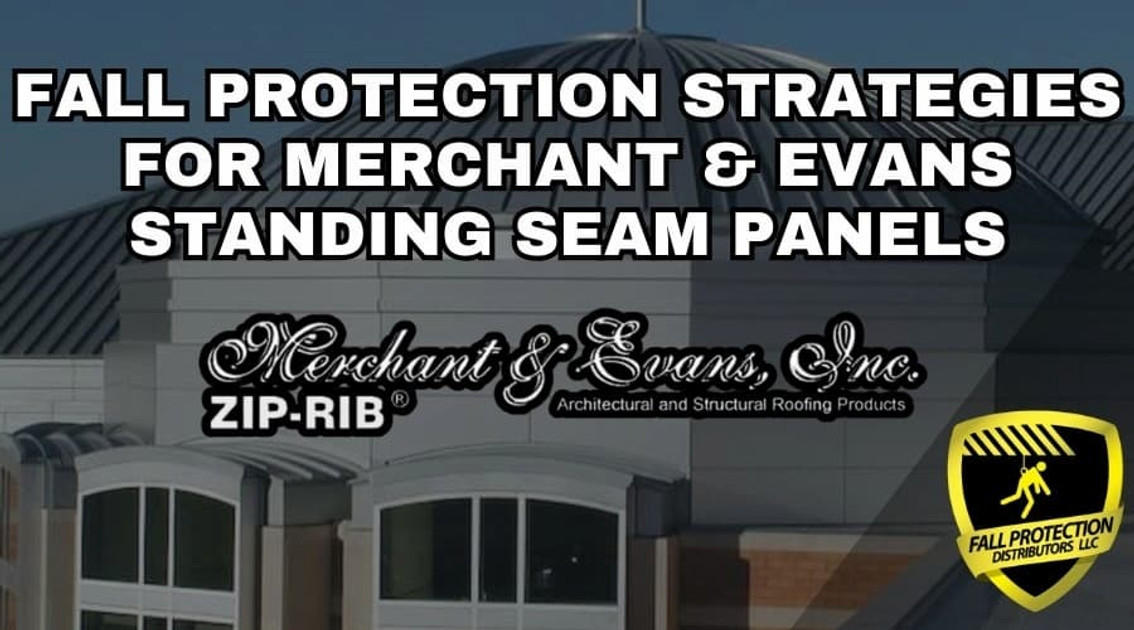Fall Protection Strategies For Merchant & Evans Standing Seam Roofs
Posted by Howie Scarboro - CEO Fall Protection Distributors, LLC on Nov 25th 2025
See the Roof Anchor Compatibility Chart for Merchant and Evans Standing Seam Panels.

Who Is Merchant and Evans?
Merchant and Evans has been part of the American roofing landscape for more than a century. The story begins in 1866, when the company supplied metal products to builders who needed dependable materials that could withstand demanding environments.
Things changed in a big way in 1964 when Merchant and Evans introduced the ZIP RIB system, a structural standing-seam roof based on a Kaiser Aluminum innovation. That system became a turning point for the entire industry. Crews finally had a panel that locked mechanically, carried its own structural load, and stayed weather-tight through decades of abuse.
The ZIP RIB panel quickly became the signature roof in their catalog. It performed in harsh climates, long spans, and complex geometry that other panels struggled with. Once architects realized they could curve, taper, and wrap it around almost anything without sacrificing strength, ZIP RIB began appearing on projects worldwide.
Merchant and Evans never drifted from that original focus on engineering. The company produces roofing, wall panels, fascia, soffit systems, perimeter trims, and accessories that give architects freedom to build whatever they can sketch. They offer a wide range of metals, profiles, and finishes, which makes it easier to match new construction or restore historic structures without compromise. Their partnership with IMETCO only strengthened that approach, giving them more capacity, better tooling, and an expanded range of high-performance solutions.
What Is The Best Fall Protection For Merchant and Evans Standing Seam Roofs?
Safe work on Merchant and Evans panels starts with understanding the seams, the metal, and which anchors protect both.
Merchant and Evans roofs show up on projects where performance matters. That usually means crews are dealing with tall buildings, long spans, and architectural details that can challenge a traditional safety plan. A reliable fall protection system becomes part of the job from the minute the first worker steps off the ladder. Every anchor has to sit correctly on the seam, match the metal gauge, and protect the weather-tight seal that Merchant and Evans panels are known for.
This article walks through the safest approach to tie off on these roof systems. Compatibility matters when a panel uses structural ribs, aluminum substrates, or curved panels, as these features change how loads transfer through the panels.
The sections that follow present each Merchant and Evans panel and outline the most compatible fall protection solutions for each. You will see where the SSRA1 Seam Anchor works well on 22-gauge and 24-gauge steel, where the SSRA2 Adjustable Roof Jack gives a safer work platform, when the SSRA3 Anchor Plate helps crews set up a temporary horizontal lifeline, and where the Ridge Pro Steep Assist becomes the better choice for aluminum, tapered, or curved installations. You will also see when radius roofs fall outside standard recommendations and require a trained safety professional to inspect the structure before any work begins.
By taking time to match the right equipment to the exact panel profile, contractors keep workers safe, protect the roof warranty, and avoid the expensive repairs that come from improper tie-off. When you follow the fall protection practices outlined in this guide, Merchant and Evans roofs remain secure from the start of the project to the last trip down the ladder.
Zip-Rib Mechanical Panel
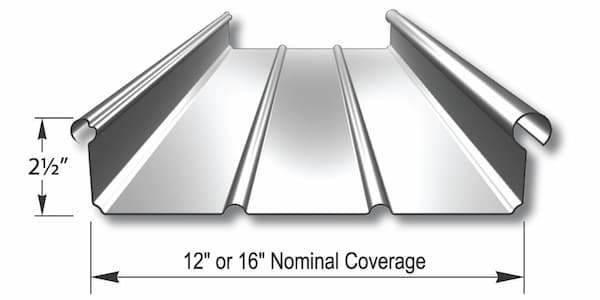
Zip-Rib's structural rib and curved capabilities change how safety managers plan worker safety on Merchant and Evans roofs.
Zip-Rib has been the signature Merchant and Evans panel for decades. It appeared in 1964 and immediately reshaped how architects approached metal roofs. The tall 2.5-inch rib acts like a miniature structural beam. Once the seams are mechanically locked, the panels deliver impressive strength across wide roof areas. That performance is why Zip-Rib still appears on civic buildings, universities, sports facilities, transit hubs, and restoration work where reliability matters most. See the Roof Anchor Compatibility Chart for Merchant and Evans Zip-Rib Standing Seam Panels.
Crews can run Zip-Rib panels for 400 feet or more, then transition into a barrel, a cone, or a gentle curve. It works on slopes as low as 1/4:12. It also performs well on vertical walls, convex and concave shapes, and conical tapers that demand tight radius control. Architects like it because they can take a complex design and execute it in the real world.
Zip-Rib holds a long list of approvals that support its reputation. It has a Dade County Notice of Acceptance. It meets FM 4471 Class 1 roof assembly standards. Steel and aluminum versions carry a UL 90 wind uplift rating. The system also passes demanding wind and water tests, including ASTM E1680, ASTM E1646, and AAMA 501. For fire performance, it carries a UL Class A rating.
Steel options include 24-gauge, 22-gauge, and 20-gauge Galvalume. Stainless steel is available in 24-gauge and 22-gauge. Aluminum options include .032, .040, and .050 thicknesses. Standard widths are 12 and 16 inches, with lengths up to 90 feet.
Fall Protection For Zip-Rib Panels
Choosing the safest anchor depends on the metal, the gauge, and whether the roof panels are straight or curved.
For 20-, 22-, and 24-gauge steel Zip-Rib panels, the SSRA1 Seam Anchor is a viable choice for worker tie-off. It clamps to the seam without penetrating the metal. This anchor protects the weather-tight seal and maintains the roof warranty. Once locked in place, the SSRA1 gives installers a stable tie-off point as they work.
When crews need a level work platform, the SSRA2 Adjustable Roof Jack Adapter mounts atop SSRA1 anchors; this setup carries a ten-foot walkboard and adjusts for various seam heights and roof pitches.
The SSRA3 Anchor Plate mounts on SSRA1 anchors and provides an attachment point for temporary horizontal lifeline hardware. The SSRA HLL 100-foot Temporary Horizontal Lifeline Kit is well-suited for projects with larger roofs and multiple workers. For buildings that require long-term access for inspections or equipment service, the Super Anchor 120-foot Permanent HLL Kit provides a steady tie-off solution year after year. Both options allow two users to navigate long spans without damaging the seam.
Aluminum, copper, and zinc Zip-Rib panels need a different approach due to the softer base material. The Ridge Pro Steep Assist becomes the safer option because it hooks over the ridge and ties the worker off before their boots ever touch the panel. The tool keeps workers secure during the highest risk moments of climbing, descending, and moving along the ridge.
Curved Zip-Rib roofs require a trained safety professional to evaluate the structure before selecting the best fall protection strategies. A standard anchor setup that works perfectly on a straight roof might not work correctly on a curved profile.
Zip-Lok Mechanical Panel

Zip-Lok provides crews with a mechanically seamed profile that meets a wide range of architectural and structural demands.
The Zip-Lok panel offers the strength of a mechanically seamed profile without forcing designers into one specific look. The system is available in single-lock and double-lock versions, so the architect can decide how much seam strength the project requires. That flexibility is one of the reasons Zip-Lok shows up on everything from modern schools to historic restoration work. See the Roof Anchor Compatibility Chart for Merchant and Evans Zip-Lok Standing Seam Panels.
Coverage widths include 12, 16, and 18 inches, with seam heights of 1.5 or 2 inches. Those combinations give installers room to match the panel to the building's architectural style. Optional ribs and striations help flatten reflections, add stiffness, and create cleaner sight lines on long runs of metal.
Zip-Lok panels can be aluminum or 22-gauge and 24-gauge Galvalume. You can order mill finish, smooth Kynar, or stucco embossed Kynar. When the project calls for something unusual, Merchant and Evans can roll custom gauges and coatings to match the specification.
Fall Protection For Zip-Lok Panels
Matching anchors to the correct metal and gauge keeps Zip-Lok installations safe from start to finish.
Zip-Lok panels require fall protection to be compatible with the seam shape and the panel material. Steel Zip-Lok panels in 22-gauge and 24-gauge work well with the SSRA1 Seam Anchor. It clamps directly onto the seam at low torque without drilling holes or cutting into the metal. That non-penetrating approach protects the roof warranty and provides a secure tie-off point for workers.
When workers need a level work platform on steep roof sections, the SSRA2 Adjustable Roof Jack Adapters mount atop SSRA1 anchors. This setup includes a ten-foot walkboard and provides workers with a level platform on roofs that may feel uncomfortable without one.
The SSRA3 Anchor Plate mounts on SSRA1 anchors to create a reliable connection point for temporary horizontal lifeline hardware. The SSRA HLL 100-foot Temporary Horizontal Lifeline Kit is for projects that require maximum worker mobility on larger roof areas. Buildings that need long-term maintenance access often use the Super Anchor 120-foot Permanent HLL Kit. Both options allow two users to work safely without damaging the seam or restricting movement.
Aluminum Zip-Lok panels call for a different approach because aluminum is not compatible with seam-mounted anchors. The Ridge Pro Steep Assist becomes the safer option because it hooks over the ridge and ties the worker off before they even step onto the metal surface. Pitches between 6:12 and 12:12 benefit the most from this system. It provides a stable anchor point during some of the most dangerous moments of the job.
Curved Zip-Lok installations require a site evaluation by a trained safety professional. Any radius will change the way force moves through the seam, and standard anchors may not behave safely on those surfaces. A site-specific plan becomes part of the process. It ensures the anchor choice matches the roof's exact curve and conditions.
Classic Rib 305 Snaplock Panel

Classic Rib 305 gives builders a dependable standing seam profile built around strength, consistency, and clean visual lines.
The Classic Rib 305 system features a 1.5-inch seam and is available in 12-inch and 19-inch widths. Those two sizes help designers scale the panel to the building so the finished look feels intentional rather than forced. See the Roof Anchor Compatibility Chart for Merchant and Evans Classic Rib 305 Standing Seam Panels.
The Classic Rib 305 panel is a reliable 24-gauge Galvalume. The Kynar coating adds the color stability needed for projects that expect the roof to look sharp ten or twenty years down the road.
The panel works on slopes of 3:12 or steeper, making it a good fit for many commercial and institutional buildings. Lengths reach 45 feet, and the system performs well on straight runs, vertical walls, and conical tapers. That flexibility helps contractors move from one portion of the building to the next without switching panel types or juggling multiple fastening methods.
Classic Rib 305 carries UL 580 approval for uplift resistance and holds a UL Class 90 Construction listing under design numbers 301 and 342A. The panel also meets ASTM E283 air leakage requirements and ASTM E331 water penetration standards. Taken together, those tests give the system a reliable track record on roofs that expect long service life.
Fall Protection For Classic Rib 305 Panels
Safe work on Classic Rib 305 starts with a seam anchor that matches the 24-gauge steel profile.
The Classic Rib 305 makes fall protection planning easier than with many other panels. Every panel is 24-gauge steel. Every seam is the same height. That means contractors can rely on consistent anchor performance from one end of the roof to the other.
The SSRA1 Seam Anchor matches this panel perfectly. It clamps to the seam without drilling into the roof, which protects the weather tightness and avoids the repair work that often follows penetrations. Once the anchor is locked in place, workers have a solid tie-off point, whether they are installing long runs of metal or finishing detail areas near transitions and edges. The grip remains steady through temperature swings, which helps maintain consistent safety throughout the day.
Crews who need a working platform on steep metal roofs can add the SSRA2 Adjustable Roof Jack Adapters on top of two SSRA1 anchors. This setup carries a ten-foot walkboard and creates a level surface across the slope. That platform helps installers stay comfortable while setting clips, fastening trim, or managing heavier materials.
The SSRA3 Anchor Plate attaches to SSRA1 anchors to create a mounting point for horizontal lifeline hardware. From there, the SSRA HLL 100-foot Temporary Horizontal Lifeline Kit spans large sections of the roof, allowing two workers to move freely during roofing projects. Suppose the building needs an anchor system that stays in place for future maintenance. In that case, the Super Anchor 120-foot Permanent HLL Kit becomes the better option. Both lifeline systems reduce risk while protecting the panel's seam shape.
The Ridge Pro Steep Assist is an excellent alternative anchor option for 6:12 to 12:12 pitch roofs.
Traditional Rib 306 Batten-Cover Panel (Not SSRA Compatible)

Traditional Rib 306 blends a classic look with dependable performance across a wide range of architectural roofs.
The Traditional Rib 306 panel gives architects the classic ribbed appearance without sacrificing the durability expected from a Merchant and Evans system. You can find it in residential homes, municipal buildings, commercial projects, and wall cladding because it satisfies both visual and structural needs. See the Roof Anchor Compatibility Chart for Merchant and Evans Traditional Rib 306 Standing Seam Panels.
The panel comes in 11.5-inch and 19.5-inch widths with a 1-inch seam. That slim rib gives the roof a more refined look compared to taller structural profiles. Installers can order panel lengths up to 45 feet, which makes it easier to reduce end laps and keep the building envelope tight. The system performs well on slopes of 3:12 or steeper. It can be installed on vertical walls, conical tapers, and radius barrels when the project calls for more complex roof shapes.
Traditional Rib 306 panels are 24-gauge Galvalume. Merchant and Evans will also roll the panel in other materials and gauges when designers need a specific look or performance characteristic. Custom coatings are available for projects with strict color or environmental requirements.
The panel carries a strong set of performance approvals. It meets the UL 580 test for uplift resistance. It holds a UL Class 90 Construction listing under design number 443 when installed over 5/8 inch plywood. It also meets ASTM E283 for air leakage and ASTM E331 for water penetration.
Fall Protection For Traditional Rib 306 Panels
For non-curved Traditional Rib 306 panels, the batten-strip cover prevents the use of seam-mounted fall protection anchors.
The Ridge Pro Steep Assist becomes the better option. It hooks over the ridge and ties the worker off before their boots touch the metal. The Ridge Pro is compatible with most roofs with a 6:12 to 12:12 pitch.
Curved Traditional Rib 306 installations need a site-specific safety plan. Radius barrels, conical tapers, and similar designs alter how fall protection will perform. A trained safety professional should review the roof before selecting compatible anchors. That personal on-site evaluation ensures the fall protection plan matches the exact conditions of the curved surface.
Batten-Tite Box-Seam Panel (Not SSRA Compatible)
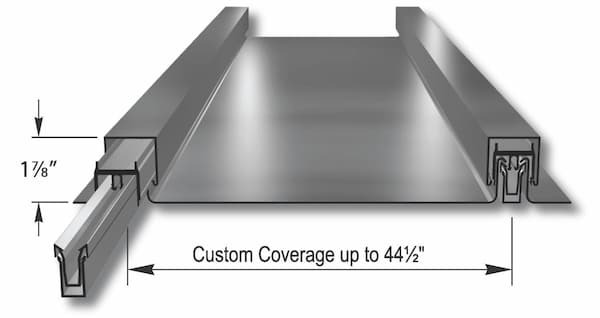
Batten-Tite creates a batten cap profile that changes how the roof performs and how workers will use fall protection anchors.
The Batten Tite panel gives architects the look and depth of a traditional batten system while delivering the durability for which Merchant and Evans is known. The seam stands 1-7/8 inches tall, and the panel can stretch out to 44 inches wide. That scale gives designers enough freedom to shape bold rooflines without losing the clean rhythm of the batten cover. See the Roof Anchor Compatibility Chart for Merchant and Evans Batten-Tite Box-Seam Standing Seam Panels.
The panel works on slopes of 3:12 and steeper. Installers can run lengths up to 45 feet, which helps reduce panel breaks on large roofs. Contractors use it on conical tapers, convex and concave curves, radius work, and even domes. It performs just as well on vertical walls, which makes the profile attractive for mixed roof and wall assemblies where continuity matters.
The panel comes in a wide range of metals. Steel options include 24-, 22-, and 20-gauge Galvalume. Aluminum arrives in .032, .040, and .050 thicknesses in 3004 alloy. Stainless steel versions include 24-gauge and 22-gauge. Copper is available in 16-ounce and 20-ounce sizes. Zinc options include .7, .8, and 1.0 millimeters. You can order smooth or stucco embossed surfaces in mill finish or with a 1.0 mil Kynar coating. Merchant and Evans also produces custom gauges and coatings when architectural specifications call for precision.
Batten-Tite carries the necessary approvals for architectural work. It meets UL testing requirements and passes ASTM E330 for structural performance and ASTM E331 for water penetration.
Fall Protection For Batten-Tite Panels
The batten cover design prevents seam-mounted anchors from working safely, so roof peak anchorage becomes the primary option.
The complete batten cover prevents any clamp-style seam anchor from safely grabbing the seam. A different approach is required so workers stay protected while the roof remains watertight.
For non-curved Batten-Tite installations, the Ridge Pro Steep Assist Anchor is the most logical option. It hooks over the ridge and provides a secure tie-off point before the worker steps onto the panel. Roofs between 6:12 and 12:12 see the most significant benefit, as the tool stabilizes the worker during the most dangerous moments of climbing, descending, and traversing the ridge.
Curved Batten Tite roofs demand even more caution. Conical tapers, convex and concave surfaces, and dome work alter how anchors attach to the roof system. A trained safety professional should inspect the project before the first worker ties in. That review helps determine whether a ridge-mounted anchor is safe or whether the project requires a custom-engineered fall protection plan.
B1515R Batten Seam Panel (Not SSRA Compatible)
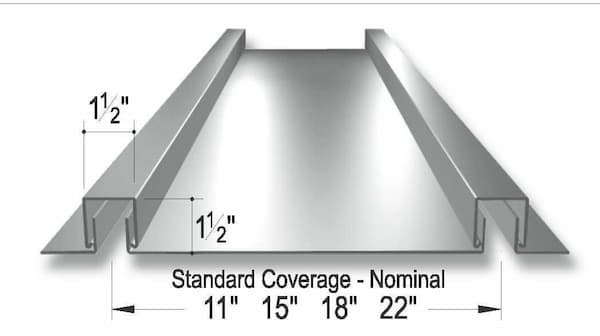
The B1515R system uses a full batten cover and box-seam profile, which changes how the roof performs and how you protect it.
The B1515R panel gives architects a sharp, boxed batten look with enough flexibility to fit a wide range of projects. The seam measures 1.5 inches by 1.5 inches, creating a bold visual line without overwhelming the roof. Installers can order widths of 11, 15, 18, or 22 inches. Those four options allow designers to scale the panel to the building rather than forcing a single width across the entire project. See the Roof Anchor Compatibility Chart for Merchant and Evans B1515R Standing Seam Panels.
The panel works well on 3:12 and steeper slopes and can be rolled in continuous lengths up to 45 feet. Contractors also use the B1515R on vertical walls and conical tapers, where the boxed seam helps define the shape.
Project managers can choose from aluminum, galvanized G-90 steel in 24- and 22-gauge, and aluminum-zinc-coated steel in AZ-50 and AZ-55 as panel substrates. Copper, zinc, and stainless steel are also available when the design calls for a more distinctive finish or performance characteristic.
The finish options give architects even more freedom. You can specify Kynar or metallic fluoropolymer coatings, or opt for mill finish for the metal's natural look. Some projects use brushed or anodized surfaces. Others use smooth or stucco embossed textures to control reflectivity and match building aesthetics.
Fall Protection For B1515R Panels
The full batten cover prevents seam anchors from attaching safely, so ridge-mounted systems become the primary tie-off method.
The B1515R seam features a batten cap design, which means there is no exposed rib for a clamp-style anchor to grab. SSRA products cannot attach to this profile. The safest approach is to shift the tie-off to the ridge so workers stay protected without damaging the roof.
The Ridge Pro Steep Assist Anchor becomes the recommended choice for straight runs of the B1515R. The unit hooks over the roof peak and gives workers a secure tie-off point before they step onto the metal surface. Roofs with slopes between 6:12 and 12:12 benefit the most, as the Ridge Pro helps stabilize the worker during climbing, descending, and traversing the ridge.
Curved applications require extra care. Conical tapers, radius work, and other non-linear surfaces alter how force travels through the batten cap and the underlying panel. A trained safety professional should inspect the project before deciding on the most appropriate fall protection strategy. That review ensures the fall protection method matches the exact geometry and avoids unintended loads that could damage the panel.
Merchant and Evans 114-R Box-Seam Panel (Not SSRA Compatible)
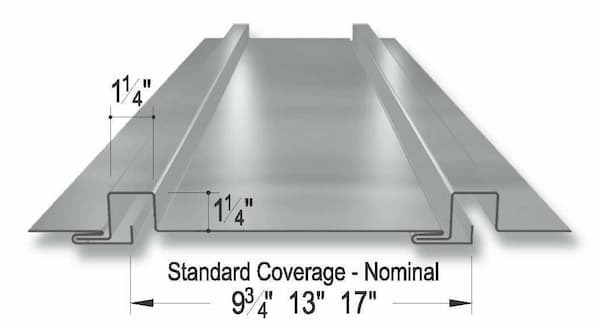
The 114-R panel offers a clean architectural profile that performs well on steep roofs, long spans, and visually demanding projects.
The 114-R panel fits neatly into the Merchant and Evans architectural family. It brings a clean, modern appearance that works on residential, commercial, and institutional buildings without feeling out of place. The panel performs on slopes of 3:12 or greater, which opens the door to a broad range of roof shapes and design concepts. Builders like it because it installs cleanly. Architects like it because it delivers the crisp lines they want without forcing material compromises. Box seams are 1.25 inches high and 1.25 inches wide. See the Roof Anchor Compatibility Chart for Merchant and Evans 114-R Standing Seam Panels.
Continuous lengths up to 45 feet give the system a noticeable advantage. Long panels make the roof look smoother and reduce end laps that often interrupt the visual flow of a building. Fewer seams also mean fewer opportunities for leaks down the road.
Material options include aluminum and 22-gauge and 24-gauge steel. Copper and aluminum are also available for projects that need a more refined appearance or want to match historic details. That variety gives architects enough freedom to match the panel to the building style instead of forcing the design to work around the metal.
Fall Protection For Merchant and Evans 114-R Panels
The shape of the 114-R profile rules out seam-mounted anchors, so ridge-mounted tie-off becomes the safest option.
The Ridge Pro Steep Assist Anchor is an excellent choice for this panel. It hooks over the ridge and creates a predictable tie-off point for slopes between 6:12 and 12:12. Workers rely on it during the moments where most accidents occur. Those early steps onto the roof, the climb to the ridge, and the move back toward the ladder are the highest-risk movements on any steep metal roof. Ridge-mounted anchorage helps control those moments.
The Ridge Pro works across aluminum, steel, and copper versions of the 114-R without compromising the finish or the weather-tight seal. That versatility matters in buildings where multiple metals appear in one assembly or when designers shift materials between different sections of the structure.
Standing Seam Roof Anchor 20 - 24 Ga. Panel Compatibility For Merchant and Evans
| Zip-Rib 20 Ga. | Zip-Rib 22 Ga. | Zip-Rib 24 Ga. | Zip-Lok 22 Ga. | Zip-Lok 24 Ga. | Classic Rib 24 Ga. | |
|---|---|---|---|---|---|---|
SSRA 1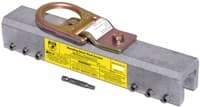 |
YES | YES | NO | YES | NO | NO |
SSRA1 Nylon Tip |
YES | YES | YES | YES | YES | YES |
SSRA2 Roof Jack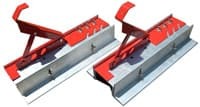 |
YES | YES | YES | YES | YES | YES |
SSRA3 Anchor Plate |
YES | YES | YES | YES | YES | YES |
The Ridge Pro |
YES | YES | YES | YES | YES | YES |
Standing Seam Roof Anchor Panel Compatibility For Merchant and Evans
| Traditional Rib 306 Batten-Cover | Batten-Tite Box-Seam | B1515R Batten Seam | 114-R Box-Seam | |
|---|---|---|---|---|
SSRA 1 |
NO | NO | NO | NO |
SSRA1 Nylon Tip |
NO | NO | NO | NO |
SSRA2 Roof Jack |
NO | NO | NO | NO |
SSRA3 Anchor Plate |
NO | NO | NO | NO |
The Ridge Pro |
YES | YES | YES | YES |
Contact Us for Expert Standing Seam Fall Protection Advice
For expert guidance on standing seam roof anchors, lifeline kits, and fall protection systems that protect both your crew and your panels, contact us today at 863-703-4522 or visit www.StandingSeamRoofAnchor.com. Our safety specialists can help you match the right non-penetrating anchor to your specific roof profile and slope. Let's make your next metal roofing project safe, compliant, and built to last. For continued learning, download OSHA's 48-page Fall Protection Manual and our free Anchor Inspection Form once you've selected the ideal anchors for your roof system. Together, we'll help you stay ahead of OSHA standards while preserving your roof's weather-tight seal.
Safety Tips For Standing Seam Roofs
Equip Workers with High-Quality Safety Gear
A harness that hugs the worker correctly, a Malta Dynamics SRL that pays out smoothly on a long Merchant and Evans run, and connectors that pass a quick hands-on inspection give workers confidence before they ever climb the ladder. With OSHA tightening expectations around fit and adjustment in 2025, safety managers should treat harness sizing the same way they treat anchor selection.
Set Up Protective Guardrail Barriers for Work Zones
Guardrails still rank among the simplest ways to keep crews safe on larger jobsites. They block off skylights, edges, and material-staging zones, helping workers stay alert in areas where distractions can creep in easily.
Consult Experts for Curved Metal Panels
A conical taper, dome surface, or long curved panels require additional scrutiny regarding fall protection. A fall protection expert should evaluate those designs before choosing anchors. That review protects workers and prevents damage to curved ZIP-RIB or B1515R installations that might react differently under load than traditional, non-curved panels.
Use Specialized Anchor Systems for Standing Seam Roofs
Standing seam systems demand anchors that grip without breaking the metal's weather-tight seal. SSRA1 anchors use stainless steel set screws that apply low-torque pressure across a twelve-inch span of the seam instead of relying on high torque or guesswork about hidden clips. Many older clamp devices use ft-lb torque levels that risk deforming a seam on a 24-gauge Merchant and Evans panel.
Promote a Culture of Safety
A five-minute conversation before work begins has more influence than any manual. A culture that encourages workers to point out concerns creates safer job sites without forcing compliance through paperwork alone.
Encourage the Use of Trauma Straps
A fall arrest event is only the start of a worker's challenge. Trauma straps give a suspended worker a way to shift their weight and avoid circulation problems as the rescue plan unfolds. Safety managers should treat trauma straps as required equipment.
Develop OSHA-Compliant Safety Plans
A written safety plan identifies anchor points, defines whether crews will work in restraint or arrest, and defines rescue procedures before workers step on the roof. When workers know the plan, risk drops, and safety managers spend less time correcting improvised tie-offs.
Prioritize Ladder Safety Training
Far too many jobsite falls occur on ladders, not on the metal roof. Workers need to check rails and rungs, maintain three points of contact, and set ladders using the four-to-one rule. When the ladder work looks sloppy, the roof work usually follows.
Install Permanent Roof Anchor Systems
Some Merchant and Evans roofs require ongoing access for HVAC checks, snow retention service, or seasonal inspection. A permanent safety line, such as the Super Anchor 120-foot Permanent Horizontal Lifeline Kit, becomes a long-term solution that avoids roof penetrations and reduces setup time. It lets maintenance crews clip in quickly, work predictably, and stay compliant with OSHA and ANSI requirements without dragging temporary equipment across the roof.
Ensure Proper Footwear for Stability
Slip-resistant boots with firm ankle support help workers stay balanced on smooth Kynar finishes. Good footwear paired with a solid tie-off point creates a simple formula: traction, balance, and fall protection working together.
Disclaimer
The views, recommendations, and information presented in this blog are solely those of the author and do not necessarily reflect the opinions or positions of the featured panel manufacturer, its brands, subsidiaries, or parent companies. Customers are strongly encouraged to contact the roof panel manufacturer directly for inquiries regarding fall protection compatibility with their products and to address any potential warranty issues that may arise after installing our products.

